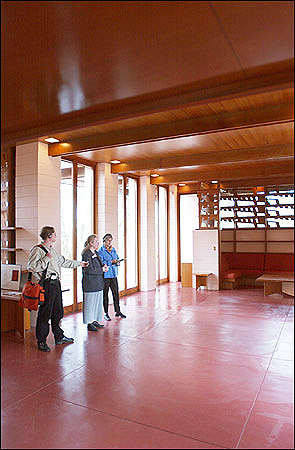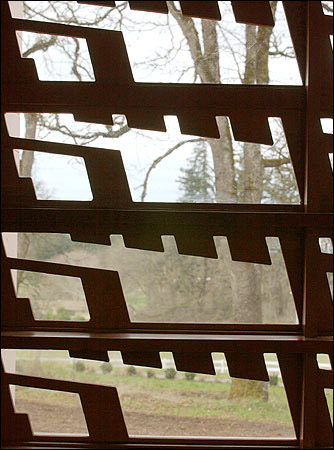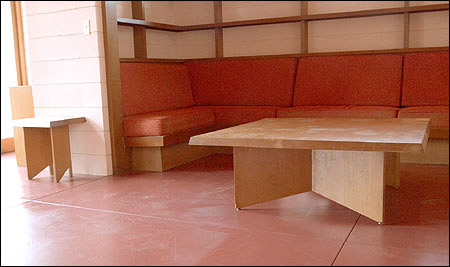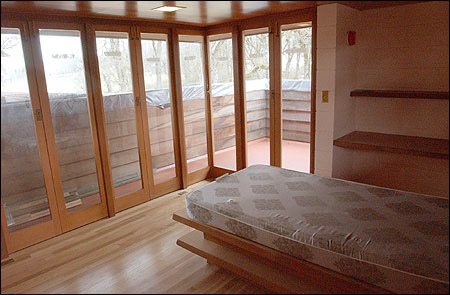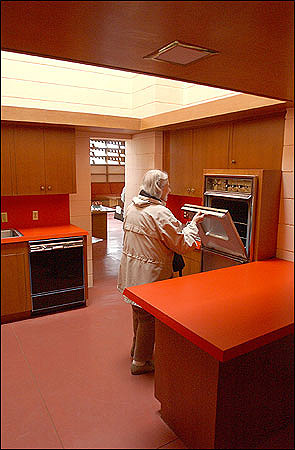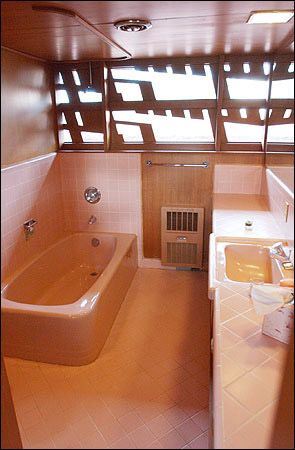Conrad and Evelyn Gordon Residence, Wilsonville, Oregon (1956) (S.419)
(Note, due to the fact that the internet is constantly changing, and items that
are posted change, I have copied the text, but give all the credits available.)
Short Trips: Wright home a tribute to preservation efforts
February 28, 2002
Written and photographed by Jeff Larsen
http://seattlepi.nwsource.com/getaways/59978_shorttrips28.shtml
SILVERTON, Ore. -- Consider it a special moment this Saturday when the public will be allowed to step into the Gordon House at the Oregon Garden in Silverton for the first time. It will be a rare opportunity to physically touch such an extraordinary piece of art and history in the Northwest.
You might call the Gordon House a story of salvation. Designed by pre-eminent American architect Frank Lloyd Wright, the house was set to be demolished about 18 months ago.
It originally was designed for Evelyn and Conrad Gordon in Wilsonville, Ore., by Wright in 1956-57, when he was in his late 80s. Built in 1963, four years after his death, the house recently was sold and the owners planned to build a new home on the property.
A preview of the Gordon House, which will be dedicated this weekend, shows the home's 12-foot-high natural wood ceilings. The Gordon House in Oregon, designed by Frank Lloyd Wright, has a unique "perforated" window
design.Virtually at the last minute, enter the Frank Lloyd Wright Building Conservancy, based in Chicago. Started in 1989, the conservancy boasts that not one Wright-designed structure has been lost since the organization's inception. In 1970 only two Wright-designed homes were open to the public. Currently about 20 nationwide are open, and they drew more than 1 million visitors last year. The Gordon House is the only Frank Lloyd Wright-designed home in Oregon and the only one open to the public in Oregon, Washington and Idaho.
Called a Usonian house -- Wright referred to the United States as Usonia -- the Gordon House is only one of two homes that were built strictly from a commission Wright got from Life magazine in 1938 to design "a house for a family of $5,000-$6,000 yearly income." The homes were intended for a family with "moderate" means. (There are three Usonian houses in the greater King County area.)
Some of the living room furniture designed by Frank Lloyd Wright for the living room of the Gordon House at the Oregon Garden in Silverton, Oregon. Wright liked to design furniture for most of his home. If he didn't design all of the furniture he would suggest what would and wouldn't work in one of his homes. In November 2000, just hours before a hearing to consider an application to issue a demolition permit, it was announced that the new owners had agreed to donate the Gordon House to the conservancy. The deal called for the conservancy to sell it to someone "willing and able to dismantle and remove the house within 105 days."
Preservation was a big issue for the conservancy. Whoever bought the house had to agree to "retain as much of the original fabric intact as possible ... restore the house after it is moved and agree to donate to the conservancy a preservation easement to ensure its preservation in perpetuity."
The new owners also would be required to apply for a national landmark register and local landmark designation for the house at its new location.
One of the upstairs bedrooms. The conservancy set the minimum cost to move the house at $300,000, to restore it another $300,000, plus $30,000 for the easement donation and another $70,000 to cover conservancy expenses.
In December 2000, the Oregon Garden, situated in Silverton about 65 miles south of Portland, was selected from several different bids. A year ago the final pieces of the house arrived at the Oregon Garden location, four days before the deadline for removal from the previous location.
It ended up costing $1.1 million to move and reconstruct the house. The Oregon Garden now has to raise another $400,000 to complete the restoration and enhancement of the property.
One of the key reasons the Oregon Garden won the bid was the Silverton location. The oak grove on the property suited Frank Lloyd Wright loyalists because of Wright's insistence that buildings grow naturally from their surroundings. Wright preached that if you revered nature, it would never fail you.
When you walk into the home, it's as if you can feel Wright's presence. Twelve-foot-high natural wood ceilings with equally tall glass doors on both sides of the living room give the immediate impression this is where Wright wanted people to spend most of their time in the home. A large cornered fireplace adds a comfort level to the space.
The two-story cinder block Gordon House has a small basement that will not be open to the public. Just around the corner from the basement door, the kitchen -- with its bright orange Formica countertops -- is small but feels more spacious because of a large skylight. All the appliances are vintage 1963.
Gordon House visitor checks out the original 1963 vintage oven in the kitchen of the house. The upstairs bathroom with all of the original fixtures. Wright's interest in traditional Japanese architecture late in his career is evident in the 2,133-square-foot Gordon House, with its unique "perforated windows," open floor plan, overhanging eaves and shallow pitched roof.
One of Wright's Usonian house innovations was to build the structure on a thick concrete slab encasing steam pipes to heat the house.
The upstairs and downstairs bedrooms are small, but all three are fitted with glass doors that open to upper and lower deck areas and provide plenty of available light. All the rooms have built-in cabinets and drawers.
The Gordon House design is characterized as architecture, but it's more than that: It stands now in the Oregon Garden gallery in the small town of Silverton as a piece of art created by a man many consider to be the greatest American architect of all time.
All Photographs by Jeff Larsen/Seattle Post-Intelligencer, February 28, 2002.
BACK HOME ARTIFACTS AUDIO BOOKS PERIODICALS PHOTOS POSTCARDS POSTERS STAMPS STUDIES ASSISTING ABOUT SEARCH
©Copyright 2008
